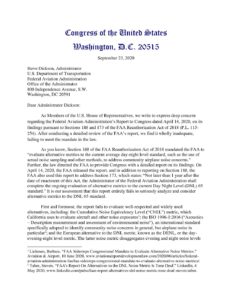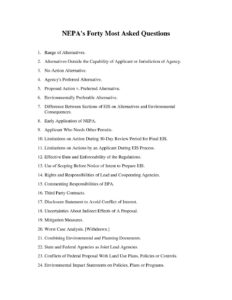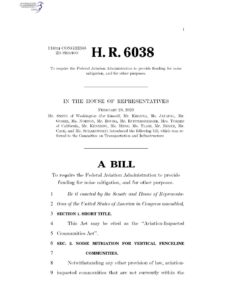Press Release Washington, D.C. – A bill introduced by Congressman Sam Graves (MO-06) to ensure that Airport Improvement Program (AIP) funds can be used by airports to incentivize the early completion of critical runway and airport projects was approved by the House of Representatives today. North Missouri airports depend on AIP funding to make needed improvements. The
Congressional Quiet Skies Caucus Letter To FAA Administrator Steve Dickson re DNL65
Discussion:
 Currently, FAA law has extremely complicated rules for establishing a noise boundary around airports. (A noise boundary is a geographic area inside which there is ...
Currently, FAA law has extremely complicated rules for establishing a noise boundary around airports. (A noise boundary is a geographic area inside which there is ...
White Paper: FAA Re-authorization Act 2018

New aircraft-noise rule would do little to quiet the skies: government report
By Jon Hemmerdinger 24 August 2020 A ban on aircraft that do not meet new noise standards would do little to reduce overall aircraft noise and would impose costly requirements on airlines and aerospace manufacturers. That is according to a 20 August report from the US Government Accountability Office into the likely impact of a
NEPA Forty Most Asked Questions
 1. Range of Alternatives. 2. Alternatives Outside the Capability of Applicant or Jurisdiction of Agency. 3. No-Action Alternative. 4. Agency’s Preferred Alternative. ...
1. Range of Alternatives. 2. Alternatives Outside the Capability of Applicant or Jurisdiction of Agency. 3. No-Action Alternative. 4. Agency’s Preferred Alternative. ...
CFR Title 14 Part 161 NOTICE AND APPROVAL OF AIRPORT NOISE AND ACCESS RESTRICTIONS
Title 14: Aeronautics and Space PART 161—NOTICE AND APPROVAL OF AIRPORT NOISE AND ACCESS RESTRICTIONS Contents Subpart A—General Provisions §161.1 Purpose. §161.3 Applicability. §161.5 Definitions. §161.7 Limitations. §161.9 Designation of noise description methods. §161.11 Identification of land uses in airport noise study area. Subpart B—Agreements §161.101 Scope. §161.103 Notice of the proposed restriction. §161.105 Requirements for new entrants. §161.107 Implementation of the restriction. §161.109 Notice of
Missed opportunity or necessary avoidance? FAA Noise Metrics Report to Congress
TOPICS:16hr2020 Report to Congress (“Report”)April 14average day-night level standardBarbara LichmanCDNLCNELconcentrated noise impact pointsLAeqLdenLmaxNAnoise metricsPart 150SELTA Posted By: Cynthia Schultz June 16, 2020 Share this article: Missed opportunity or necessary avoidance? Cynthia Schultz, PE While it would be easy to take the FAA to task for ignoring the congressional mandate, it is not so easy
FAA Sidesteps Congressional Mandate to Evaluate Alternative Noise Metrics
Posted in Federal Aviation Administration (FAA) In the FAA Reauthorization Act of 2018, Pub. L. 115254, § 188, Congress required the Federal Aviation Administration (“FAA”) to “evaluate alternative noise metrics to current average day-night level standard, such as the use of actual noise sampling to address community airplane noise concerns.” In its April 14, 2020
Aviation Noise & Emissions Symposium 2020
The 2020 UC Davis Aviation Noise and Emissions Symposium will focus on defining the challenges that face the noise and emissions industry over the next few years and discussing real-world solutions. Symposium Presenters will share ground-breaking efforts being undertaken by elected officials, airports, consultants, communities, and the FAA to mitigate noise and environmental impacts of
HR 6038 Aviation-Impacted Communities Act (2020 version)
Discussion:
 An earlier version of this bill was introduced into the 115th Congress as HR6168...
An earlier version of this bill was introduced into the 115th Congress as HR6168...